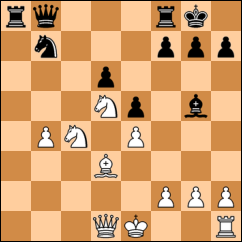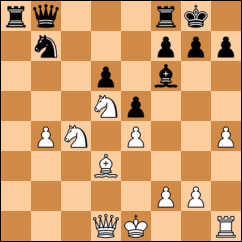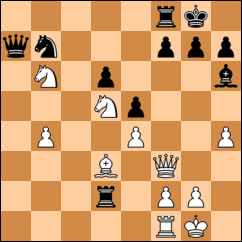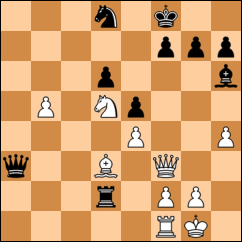I found a great game by Kasparov where he sacrifices an exchange to contain a piece. Kingcrusher has a nice video so I will link to that rather than inputting the game myself. I will focus on an analysis of sidelines in upcoming posts.
Kasparov - Shirov Horgen 1994
This is a very popular game and features highly in many top games lists including Informant's best games of all time collection.
Link at chessgames.com
Now lets get to analysis. I will start with the position after 22...Qb8:

Some commentators have pointed out 22...Ra2 as a possible improvement. I will look at that position later on. Now it is White to move:
Minor Pieces: White has an extra one at the expense of a rook. The d5 knight is quite well placed. The c4 knight is also threatening. The key to the position is the restriction of the Black knight on b7. The d3 bishop is there just to be out of the way. The Black bishop on g5 is Black's best minor piece.
Pawn Structure: White has a passed b pawn which can become of use towards an ending. The Black d6 pawn is backward and is one of the features of the position restricting the b7 knight.
Space: A slight edge to White in overall terms but the key feature here is the lack of squares for the b7 knight except for d8 which was just vacated by 22...Qb8. This is probably why Shirov selected that move. A routing such as Nb7-d8-e6-d4 solves all of Black's problems. White has to move quickly to keep Black from unravelling.
Material: Not to state the obvious but Black is up an exchange for a well posted knight on d5 and a restricted Black knight on b7.
Files/Ranks: Black has control of the a file.
Development: White is a bit behind as White has not castled yet. This is not however a position for ordinary moves. White needs to make some hay before Black solves the story of b7 knight.
Initiative: Each side I would say is fighting for this. Black is looking to unravel and White is looking to get some concrete threats in.
What problems does White have to solve?
1. Keep Black bottled and restrict opportunities for Black to get the rooks into the game.
2. Attend to king safety
I confess 23. h4 as played would probably not be my first choice of move. Given that White is down material I would probably consider this as a possible way to get the rook into the game via a rook lift. I do see the point now about making the Black bishop move off the confluence of two active diagonals. 23...Bh6 was played in the game. What if 23... Bf6 or 23... Bd8 ? Let's have a look:
After 23... Bf6:

24. Nf6 is tempting but that gives up White's best piece. The idea of playing 24. g4 and continuing an attack is interesting. Some concrete variations would need to be evaluated given the awkward situation of the White king. Also worthy of consideration and a move to me which feels correct intuitively is 24. Ncb6. That move especially seems worthy of a deep think. White threatens to win back the exchange but Black has some shots down the a file. A worthwhile practical analysis task. I will take a hard look and post my evaluation in an upcoming post.
Evaluation of 24. Ncb6:
24. Ncb6 Ra3 25. Nd7 Qa7 26. Nf8 Ra1 27. Bb1 Kf8 28. O-O Nd8 29. Qh5 the bad position of the b1 bishop limits White's game here. I can see some play trying promote the h pawn but all very unclear. The Black knight can dominate if it gets to d4 or f4. I would say an edge to Black or unclear.
24. Ncb6 Ra3 25. Nd7 26. N5f6 gf6 27. Qg4 Kh8 28. Nf8 but this f8 knight is awkward enough that I cannot find a convincing line for White. 28... Ra1 29. Ke2 Rh1 30. Now what? Black is about to play Qa1 and start driving the White King. The d3 bishop cannot assist much. If this is all White can get I'm going to look at other lines before looking deeper here.
The problem with the routing of the knight via b6 seems to be that it does nothing for king safety. White needs a plan to make use of pieces where they are as much as possible and especially the h1 rook. More lines upcoming.
Evaluation of 24. g4:
I like this move because it opens a square for the White king on g2 and makes ...Nd8 for Black awkward since White has g5 trapping the Black bishop. Black can consider playing that as a sacrifice in some situations. Also in White's favor here is that the White rook can be used directly on the h file. The c4 knight can be routed via e3 to f5 or just posted on e3 for defense. Black's second rook is still cut off on f8 and Black has to solve the problem of the b7 knight. Some concrete variations:
24. g4 Ra2 ( for argument's sake ) 25. Kf1 Qa7 26. Qf3 Black may be able to afford playing with a rook for 2 pieces after 26... Nd8 27. g5 Bg5 28. hg5 Ra1 ( 28... Ne6 is playable also and may be a better move. I originally thought this was not possible but now I see that it is since the Black queen on a7 covers the e7 square and prevents Ne7. The whole line seems quite playable for Black honestly. ) 29. Kg2 Rh1 30. Kh1 since material is reduced and there is no specific threat in the position. I give White an edge but Black has solved the problem of the b7 knight and the White king is a bit exposed, the d3 bishop needs something to do. I feel White is ok here and given that 24. Ncb6 didn't seem to generate anything specific I may have to play into the unclear complications of this line.
Another possible move here is simply to route the c4 knight to f5 via e3 now that the Black bishop is off of the c1-h6 diagonal. I will come back to that another time.
Position after ...Qa7:

This is my next analysis task. If I got this position in a game 15 game on ICC I would be very tempted to play something like Bb5. That gets the bishop out of a possible pin after ...Qa3. If I had more time I would consider Kasparov's move Nd7 and not that I would have played it. Since I now know it atleast draws let me try and calculate it out. Analysis in the next post.
Analysis after 27. Nd7 Ra8:
I know this is covered in the kingscrusher youtube video. I tried to visualize the line and I was just missing one bit of the puzzle for a while:
28. Ne7 Kh8 29. Qf7 Rd3 30. Nf8 Qa2 31. Nfg6 hg6 32. Ng6 Kh7 33. Nf8 and here I was asking myself why not 33... Rf8? And it took me a bit to realize that after 33... Rf8 White has 34. Qa2 which by no means is all that clear in any case but probably ok for White. Black has 3 pieces for the queen but the Black king is a bit exposed, the b7 knight needs a few moves to be useful and White has some counterplay with the b4 pawn. Black I think can certainly play that way for a win. If Black eschews that then White has a perpetual check w/ Nf8-g6-f8.
Position After 29...Qa3:

This is the beginning of a series of unexpected moves:
30. Qf5 With the threat of Qd7. The bishop at d3 cannot be captured.
30... Ke8 ok perfectly understandable 31. Bc4 Rc2 32. Qh7 Why allow the bishop to be captured now? Because it sets up a knight fork collecting the exchange. Can Black do better than lose the exchange after 32. Qh7 ? This is my next analysis task.
 Some commentators have pointed out 22...Ra2 as a possible improvement. I will look at that position later on. Now it is White to move:
Minor Pieces: White has an extra one at the expense of a rook. The d5 knight is quite well placed. The c4 knight is also threatening. The key to the position is the restriction of the Black knight on b7. The d3 bishop is there just to be out of the way. The Black bishop on g5 is Black's best minor piece.
Pawn Structure: White has a passed b pawn which can become of use towards an ending. The Black d6 pawn is backward and is one of the features of the position restricting the b7 knight.
Space: A slight edge to White in overall terms but the key feature here is the lack of squares for the b7 knight except for d8 which was just vacated by 22...Qb8. This is probably why Shirov selected that move. A routing such as Nb7-d8-e6-d4 solves all of Black's problems. White has to move quickly to keep Black from unravelling.
Material: Not to state the obvious but Black is up an exchange for a well posted knight on d5 and a restricted Black knight on b7.
Files/Ranks: Black has control of the a file.
Development: White is a bit behind as White has not castled yet. This is not however a position for ordinary moves. White needs to make some hay before Black solves the story of b7 knight.
Initiative: Each side I would say is fighting for this. Black is looking to unravel and White is looking to get some concrete threats in.
What problems does White have to solve?
1. Keep Black bottled and restrict opportunities for Black to get the rooks into the game.
2. Attend to king safety
I confess 23. h4 as played would probably not be my first choice of move. Given that White is down material I would probably consider this as a possible way to get the rook into the game via a rook lift. I do see the point now about making the Black bishop move off the confluence of two active diagonals. 23...Bh6 was played in the game. What if 23... Bf6 or 23... Bd8 ? Let's have a look:
After 23... Bf6:
Some commentators have pointed out 22...Ra2 as a possible improvement. I will look at that position later on. Now it is White to move:
Minor Pieces: White has an extra one at the expense of a rook. The d5 knight is quite well placed. The c4 knight is also threatening. The key to the position is the restriction of the Black knight on b7. The d3 bishop is there just to be out of the way. The Black bishop on g5 is Black's best minor piece.
Pawn Structure: White has a passed b pawn which can become of use towards an ending. The Black d6 pawn is backward and is one of the features of the position restricting the b7 knight.
Space: A slight edge to White in overall terms but the key feature here is the lack of squares for the b7 knight except for d8 which was just vacated by 22...Qb8. This is probably why Shirov selected that move. A routing such as Nb7-d8-e6-d4 solves all of Black's problems. White has to move quickly to keep Black from unravelling.
Material: Not to state the obvious but Black is up an exchange for a well posted knight on d5 and a restricted Black knight on b7.
Files/Ranks: Black has control of the a file.
Development: White is a bit behind as White has not castled yet. This is not however a position for ordinary moves. White needs to make some hay before Black solves the story of b7 knight.
Initiative: Each side I would say is fighting for this. Black is looking to unravel and White is looking to get some concrete threats in.
What problems does White have to solve?
1. Keep Black bottled and restrict opportunities for Black to get the rooks into the game.
2. Attend to king safety
I confess 23. h4 as played would probably not be my first choice of move. Given that White is down material I would probably consider this as a possible way to get the rook into the game via a rook lift. I do see the point now about making the Black bishop move off the confluence of two active diagonals. 23...Bh6 was played in the game. What if 23... Bf6 or 23... Bd8 ? Let's have a look:
After 23... Bf6:
 24. Nf6 is tempting but that gives up White's best piece. The idea of playing 24. g4 and continuing an attack is interesting. Some concrete variations would need to be evaluated given the awkward situation of the White king. Also worthy of consideration and a move to me which feels correct intuitively is 24. Ncb6. That move especially seems worthy of a deep think. White threatens to win back the exchange but Black has some shots down the a file. A worthwhile practical analysis task. I will take a hard look and post my evaluation in an upcoming post.
Evaluation of 24. Ncb6:
24. Ncb6 Ra3 25. Nd7 Qa7 26. Nf8 Ra1 27. Bb1 Kf8 28. O-O Nd8 29. Qh5 the bad position of the b1 bishop limits White's game here. I can see some play trying promote the h pawn but all very unclear. The Black knight can dominate if it gets to d4 or f4. I would say an edge to Black or unclear.
24. Ncb6 Ra3 25. Nd7 26. N5f6 gf6 27. Qg4 Kh8 28. Nf8 but this f8 knight is awkward enough that I cannot find a convincing line for White. 28... Ra1 29. Ke2 Rh1 30. Now what? Black is about to play Qa1 and start driving the White King. The d3 bishop cannot assist much. If this is all White can get I'm going to look at other lines before looking deeper here.
The problem with the routing of the knight via b6 seems to be that it does nothing for king safety. White needs a plan to make use of pieces where they are as much as possible and especially the h1 rook. More lines upcoming.
Evaluation of 24. g4:
I like this move because it opens a square for the White king on g2 and makes ...Nd8 for Black awkward since White has g5 trapping the Black bishop. Black can consider playing that as a sacrifice in some situations. Also in White's favor here is that the White rook can be used directly on the h file. The c4 knight can be routed via e3 to f5 or just posted on e3 for defense. Black's second rook is still cut off on f8 and Black has to solve the problem of the b7 knight. Some concrete variations:
24. g4 Ra2 ( for argument's sake ) 25. Kf1 Qa7 26. Qf3 Black may be able to afford playing with a rook for 2 pieces after 26... Nd8 27. g5 Bg5 28. hg5 Ra1 ( 28... Ne6 is playable also and may be a better move. I originally thought this was not possible but now I see that it is since the Black queen on a7 covers the e7 square and prevents Ne7. The whole line seems quite playable for Black honestly. ) 29. Kg2 Rh1 30. Kh1 since material is reduced and there is no specific threat in the position. I give White an edge but Black has solved the problem of the b7 knight and the White king is a bit exposed, the d3 bishop needs something to do. I feel White is ok here and given that 24. Ncb6 didn't seem to generate anything specific I may have to play into the unclear complications of this line.
Another possible move here is simply to route the c4 knight to f5 via e3 now that the Black bishop is off of the c1-h6 diagonal. I will come back to that another time.
Position after ...Qa7:
24. Nf6 is tempting but that gives up White's best piece. The idea of playing 24. g4 and continuing an attack is interesting. Some concrete variations would need to be evaluated given the awkward situation of the White king. Also worthy of consideration and a move to me which feels correct intuitively is 24. Ncb6. That move especially seems worthy of a deep think. White threatens to win back the exchange but Black has some shots down the a file. A worthwhile practical analysis task. I will take a hard look and post my evaluation in an upcoming post.
Evaluation of 24. Ncb6:
24. Ncb6 Ra3 25. Nd7 Qa7 26. Nf8 Ra1 27. Bb1 Kf8 28. O-O Nd8 29. Qh5 the bad position of the b1 bishop limits White's game here. I can see some play trying promote the h pawn but all very unclear. The Black knight can dominate if it gets to d4 or f4. I would say an edge to Black or unclear.
24. Ncb6 Ra3 25. Nd7 26. N5f6 gf6 27. Qg4 Kh8 28. Nf8 but this f8 knight is awkward enough that I cannot find a convincing line for White. 28... Ra1 29. Ke2 Rh1 30. Now what? Black is about to play Qa1 and start driving the White King. The d3 bishop cannot assist much. If this is all White can get I'm going to look at other lines before looking deeper here.
The problem with the routing of the knight via b6 seems to be that it does nothing for king safety. White needs a plan to make use of pieces where they are as much as possible and especially the h1 rook. More lines upcoming.
Evaluation of 24. g4:
I like this move because it opens a square for the White king on g2 and makes ...Nd8 for Black awkward since White has g5 trapping the Black bishop. Black can consider playing that as a sacrifice in some situations. Also in White's favor here is that the White rook can be used directly on the h file. The c4 knight can be routed via e3 to f5 or just posted on e3 for defense. Black's second rook is still cut off on f8 and Black has to solve the problem of the b7 knight. Some concrete variations:
24. g4 Ra2 ( for argument's sake ) 25. Kf1 Qa7 26. Qf3 Black may be able to afford playing with a rook for 2 pieces after 26... Nd8 27. g5 Bg5 28. hg5 Ra1 ( 28... Ne6 is playable also and may be a better move. I originally thought this was not possible but now I see that it is since the Black queen on a7 covers the e7 square and prevents Ne7. The whole line seems quite playable for Black honestly. ) 29. Kg2 Rh1 30. Kh1 since material is reduced and there is no specific threat in the position. I give White an edge but Black has solved the problem of the b7 knight and the White king is a bit exposed, the d3 bishop needs something to do. I feel White is ok here and given that 24. Ncb6 didn't seem to generate anything specific I may have to play into the unclear complications of this line.
Another possible move here is simply to route the c4 knight to f5 via e3 now that the Black bishop is off of the c1-h6 diagonal. I will come back to that another time.
Position after ...Qa7:
 This is my next analysis task. If I got this position in a game 15 game on ICC I would be very tempted to play something like Bb5. That gets the bishop out of a possible pin after ...Qa3. If I had more time I would consider Kasparov's move Nd7 and not that I would have played it. Since I now know it atleast draws let me try and calculate it out. Analysis in the next post.
Analysis after 27. Nd7 Ra8:
I know this is covered in the kingscrusher youtube video. I tried to visualize the line and I was just missing one bit of the puzzle for a while:
28. Ne7 Kh8 29. Qf7 Rd3 30. Nf8 Qa2 31. Nfg6 hg6 32. Ng6 Kh7 33. Nf8 and here I was asking myself why not 33... Rf8? And it took me a bit to realize that after 33... Rf8 White has 34. Qa2 which by no means is all that clear in any case but probably ok for White. Black has 3 pieces for the queen but the Black king is a bit exposed, the b7 knight needs a few moves to be useful and White has some counterplay with the b4 pawn. Black I think can certainly play that way for a win. If Black eschews that then White has a perpetual check w/ Nf8-g6-f8.
Position After 29...Qa3:
This is my next analysis task. If I got this position in a game 15 game on ICC I would be very tempted to play something like Bb5. That gets the bishop out of a possible pin after ...Qa3. If I had more time I would consider Kasparov's move Nd7 and not that I would have played it. Since I now know it atleast draws let me try and calculate it out. Analysis in the next post.
Analysis after 27. Nd7 Ra8:
I know this is covered in the kingscrusher youtube video. I tried to visualize the line and I was just missing one bit of the puzzle for a while:
28. Ne7 Kh8 29. Qf7 Rd3 30. Nf8 Qa2 31. Nfg6 hg6 32. Ng6 Kh7 33. Nf8 and here I was asking myself why not 33... Rf8? And it took me a bit to realize that after 33... Rf8 White has 34. Qa2 which by no means is all that clear in any case but probably ok for White. Black has 3 pieces for the queen but the Black king is a bit exposed, the b7 knight needs a few moves to be useful and White has some counterplay with the b4 pawn. Black I think can certainly play that way for a win. If Black eschews that then White has a perpetual check w/ Nf8-g6-f8.
Position After 29...Qa3:
 This is the beginning of a series of unexpected moves:
30. Qf5 With the threat of Qd7. The bishop at d3 cannot be captured.
30... Ke8 ok perfectly understandable 31. Bc4 Rc2 32. Qh7 Why allow the bishop to be captured now? Because it sets up a knight fork collecting the exchange. Can Black do better than lose the exchange after 32. Qh7 ? This is my next analysis task.
This is the beginning of a series of unexpected moves:
30. Qf5 With the threat of Qd7. The bishop at d3 cannot be captured.
30... Ke8 ok perfectly understandable 31. Bc4 Rc2 32. Qh7 Why allow the bishop to be captured now? Because it sets up a knight fork collecting the exchange. Can Black do better than lose the exchange after 32. Qh7 ? This is my next analysis task.







